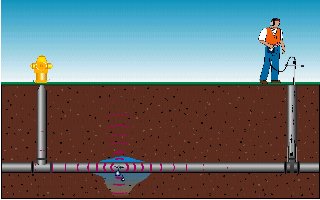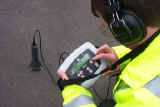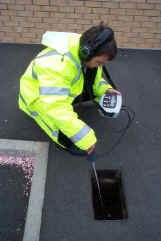Underground
Service Company provides
utility location services, independent line
testing, leak location surveys, and turn-key repairs. We
serve energy companies, water districts, environmental
engineers, and pipeline contractors.
We have included limitations,
advantages, and requirements for each survey method and the parameters required for a successful on
site test. This information is intended to be used as
a guide. For a site-specific proposal, please
contact us.
Leak Survey - Acoustic Testing
 Impact noise created
by a leak on an underground pipeline travels along the pipe
wall and through the fluid column inside the pipe.
Significantly sized leaks also create a vibration that
travels outward through the soil and to the ground surface.
This leak noise can be
identified with the help of an
acoustic listening system at available contact points to
pipeline appurtenances and ground surface over the top of
pipe. The distance to which the noise travels from the leak
outward along the pipeline and through the soil changes with
different factors, the most important being the leak rate,
the pipe size and type, and the dynamics of the surrounding
soil.
Impact noise created
by a leak on an underground pipeline travels along the pipe
wall and through the fluid column inside the pipe.
Significantly sized leaks also create a vibration that
travels outward through the soil and to the ground surface.
This leak noise can be
identified with the help of an
acoustic listening system at available contact points to
pipeline appurtenances and ground surface over the top of
pipe. The distance to which the noise travels from the leak
outward along the pipeline and through the soil changes with
different factors, the most important being the leak rate,
the pipe size and type, and the dynamics of the surrounding
soil.

Applications:
The acoustic method can be beneficial on larger leaks (1/2
gallon per minute plus) because it is a relatively fast
procedure that usually does not require the set up that a
tracer gas survey does.
The following table shows the
amount of leakage in terms of gallons per minute that is
able to be detected by the equipment on the given pipeline
from a distance of 200 feet from contact points in ideal
conditions. This table is intended as a guideline, figures
used are approximate, and results can vary with site
conditions.

|
Dia.
|
Iron
|
PVC
|
CLMC
|
Steel
|
A/C
|
|
2"
|
1/2 gpm
|
1
gpm
|
n/a
|
< 1/2 gpm
|
n/a
|
|
6"
|
3/4 gpm
|
1.5 gpm
|
1
gpm
|
1/2 gpm
|
1
gpm
|
|
18"
|
1.5 gpm
|
2.5 gpm
|
2
gpm
|
1
gpm
|
2.5 gpm
|
|
36"
|
2
gpm
|
3.5 gpm
|
2.5 gpm
|
1.5 gpm
|
n/a |
(200 psi test pressure)
If the rate of the leak is
unknown, then a pressure test should be performed if able to
aid in calculation of the rate of the leak. If a pressure
test cannot be preformed, a cursory acoustic survey should
be administered.
-
Provide all known
information on the site conditions to Underground
Service Company.
-
Ensure that contact points
are accessible.
-
Any valves or appurtenances
that are known to be faulty should be repaired prior to
the test if possible.
-
If able, tests should be
scheduled at a time when any demand, usage, pumping, and
ambient noise is at its lowest levels.
-
The client is responsible
for any required notifications.
Leak Survey - Tracer Gas Test
A mixture of 96%
helium and 4% hydrogen is combined with compressed air as it
is introduced into the piping test segment. The gas is
purged through the system allowing a full column of gas to
be present within the pipeline. A varying soak time is
required to allow the gas to escape through the leak to
permeate the soil and reach the surface where a gas analyzer
is used by an operator to record concentrations. Some
conditions may required that 1/2 inch diameter holes be
drilled through the surface area to expedite the process
such as cases of thick concrete or asphalt surfaces acting
as a "cap" to the permeating tracer gas. The operator is
able to observe readings as slight as 25 parts per million.
Applications: The tracer gas method
allows for the identification of leaks that the acoustic
method cannot. It doesn't particularly matter what type
or size of pipe is leaking. Ambient noise conditions on
site do not affect the test. The important factor for
success is enabling the tracer gas to be properly purged
through the test segment to the leak. The line must be
able to be isolated for proper purging. The tracer
method is ideal for:
-
Any type or size of pipe.
-
Smaller leaks that cannot
be found using the acoustic method.
-
Beneficial in deep
elevation and transmission lines.
|
Site Preparation:
Ideally, a test segment would include a truly isolated
system with an induction point for the gas at one end
and a venting point available for proper purging at the
opposite end. If this condition does not exist,
additional time on site may be required for purging or
added procedures. If the client is able, it is
recommended that the test segment be drained prior to
testing.
Underground Service Company provides all
piping adaptors needed for tracer induction up to 4"
I.P.T.

